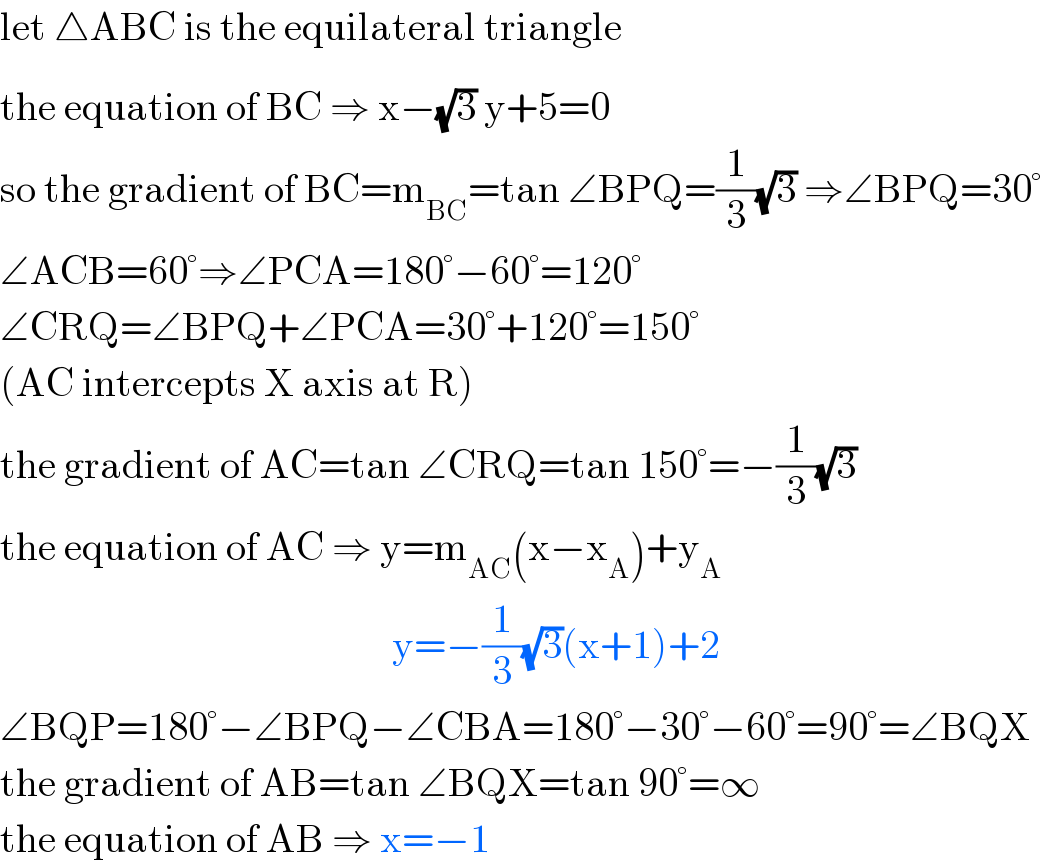Question Number 8608 by tawakalitu last updated on 17/Oct/16

$$\mathrm{if}\:\mathrm{any}\:\mathrm{angle}\:\mathrm{of}\:\mathrm{equilateral}\:\mathrm{triangle}\:\mathrm{is} \\ $$$$\left(−\:\mathrm{1},\:\mathrm{2}\right)\:\mathrm{and}\:\mathrm{any}\:\mathrm{one}\:\mathrm{side}\:\mathrm{is}\:\:\mathrm{x}\:−\:\sqrt{\mathrm{3y}}\:+\:\mathrm{5}\:=\:\mathrm{0} \\ $$$$\mathrm{then}\:\mathrm{equation}\:\mathrm{of}\:\mathrm{the}\:\mathrm{other}\:\mathrm{two}\:\mathrm{sides}\:\mathrm{are}\:?? \\ $$
Answered by sandy_suhendra last updated on 18/Oct/16

Answered by sandy_suhendra last updated on 18/Oct/16

$$\mathrm{let}\:\bigtriangleup\mathrm{ABC}\:\mathrm{is}\:\mathrm{the}\:\mathrm{equilateral}\:\mathrm{triangle} \\ $$$$\mathrm{the}\:\mathrm{equation}\:\mathrm{of}\:\mathrm{B}\overset{} {\mathrm{C}}\:\Rightarrow\:\mathrm{x}−\sqrt{\mathrm{3}}\:\mathrm{y}+\mathrm{5}=\mathrm{0}\: \\ $$$$\mathrm{so}\:\mathrm{the}\:\mathrm{gradient}\:\mathrm{of}\:\mathrm{BC}=\mathrm{m}_{\mathrm{BC}} =\mathrm{tan}\:\angle\mathrm{BPQ}=\frac{\mathrm{1}}{\mathrm{3}}\sqrt{\mathrm{3}}\:\Rightarrow\angle\mathrm{BPQ}=\mathrm{30}° \\ $$$$\angle\mathrm{ACB}=\mathrm{60}°\Rightarrow\angle\mathrm{PCA}=\mathrm{180}°−\mathrm{60}°=\mathrm{120}° \\ $$$$\angle\mathrm{CRQ}=\angle\mathrm{BPQ}+\angle\mathrm{PCA}=\mathrm{30}°+\mathrm{120}°=\mathrm{150}° \\ $$$$\left(\mathrm{AC}\:\mathrm{intercepts}\:\mathrm{X}\:\mathrm{axis}\:\mathrm{at}\:\mathrm{R}\right) \\ $$$$\mathrm{the}\:\mathrm{gradient}\:\mathrm{of}\:\mathrm{AC}=\mathrm{tan}\:\angle\mathrm{CRQ}=\mathrm{tan}\:\mathrm{150}°=−\frac{\mathrm{1}}{\mathrm{3}}\sqrt{\mathrm{3}} \\ $$$$\mathrm{the}\:\mathrm{equation}\:\mathrm{of}\:\mathrm{AC}\:\Rightarrow\:\mathrm{y}=\mathrm{m}_{\mathrm{AC}} \left(\mathrm{x}−\mathrm{x}_{\mathrm{A}} \right)+\mathrm{y}_{\mathrm{A}} \\ $$$$\:\:\:\:\:\:\:\:\:\:\:\:\:\:\:\:\:\:\:\:\:\:\:\:\:\:\:\:\:\:\:\:\:\:\:\:\:\:\:\:\:\:\:\:\:\:\:\:\:\mathrm{y}=−\frac{\mathrm{1}}{\mathrm{3}}\sqrt{\mathrm{3}}\left(\mathrm{x}+\mathrm{1}\right)+\mathrm{2} \\ $$$$\angle\mathrm{BQP}=\mathrm{180}°−\angle\mathrm{BPQ}−\angle\mathrm{CBA}=\mathrm{180}°−\mathrm{30}°−\mathrm{60}°=\mathrm{90}°=\angle\mathrm{BQX} \\ $$$$\mathrm{the}\:\mathrm{gradient}\:\mathrm{of}\:\mathrm{AB}=\mathrm{tan}\:\angle\mathrm{BQX}=\mathrm{tan}\:\mathrm{90}°=\infty \\ $$$$\mathrm{the}\:\mathrm{equation}\:\mathrm{of}\:\mathrm{AB}\:\Rightarrow\:\mathrm{x}=−\mathrm{1} \\ $$
Commented by tawakalitu last updated on 18/Oct/16

$$\mathrm{Thank}\:\mathrm{you}\:\mathrm{for}\:\mathrm{your}\:\mathrm{help}. \\ $$
